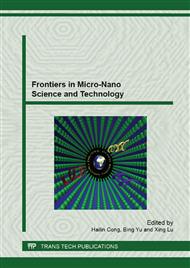[1]
N.R. Khalid, Z.L. Hong, E. Ahmed, Synergistic effects of Fe and graphene on photocatalytic activity enhancement of TiO2 under visible light, Applied Surface Science 258 (2012) 5827–5834.
DOI: 10.1016/j.apsusc.2012.02.110
Google Scholar
[2]
L. Gu, Z.X. Chen, C. Sun, B. Wei, X. Yu, Photocatalytic degradation of 2, 4-dichlorophenol using granular activated carbon supported TiO2, Desalination 263 (2010) 107–112.
DOI: 10.1016/j.desal.2010.06.045
Google Scholar
[3]
G.H. Liu, K.Y. Wang, N. Hoivik, H. Jakobsen, Progresson freestanding and flow-through TiO2 nanotube membranes, Solar Energy Materials and Solar Cells 98 (2012) 24–38.
DOI: 10.1016/j.solmat.2011.11.004
Google Scholar
[4]
S.G. Pawar, M.A. Chougule, V.B. Patil, Development of nanostructured polyaniline–titanium dioxide gas sensors for ammonia recognition, Journal of Applied Polymer Science 125 (2012) 1418–1424.
DOI: 10.1002/app.35468
Google Scholar
[5]
S.F. Chen, L. Chen, S. Gao, G.Y. Cao, The preparation of nitrogen-doped photocatalyst TiO2_xNx by ball milling, Chemical Physics Letters 413 (2005) 404–409.
DOI: 10.1016/j.cplett.2005.08.038
Google Scholar
[6]
Hongxia Menga, BingbingWanga, SongLiua, b, n, RongyingJianga, HongLong,Hydrothermal preparation characterization and photocatalytic activity of TiO2/Fe–TiO2 composite catalysts, Ceramics International 39 (2013) 5785–5793.
DOI: 10.1016/j.ceramint.2012.12.098
Google Scholar
[7]
K. Nagaveni, M.S. Hegde, GiridharMadras, Structure and photocatalytic activity of Ti1-xMxO2±δ (M=W, V, Ce, Zr, Fe, and Cu) synthesized by combustion method, Journal of Physical Chemistry B 108 (2004) 20204–20212.
DOI: 10.1021/jp047917v
Google Scholar
[8]
S. George, S. Pokhrel, Z.X. Ji, B.L. Henderson, T. Xia, L.J. Li, J.I. Zink, L. Madler, Role of Fe doping in tuning the band gap of TiO2 for the photo-oxidation-induced cytotoxicity paradigm, Journal of the American Chemical Society 133 (2011).
DOI: 10.1021/ja202836s
Google Scholar
[9]
C.Y. Wang, J. Li, S.Y. Cai, Performance improvement of dyesensitizing solar cell by semi-rigid triarylamine-based donors, Dyes and Pigments 94 (2012) 40–48.
DOI: 10.1016/j.dyepig.2011.11.002
Google Scholar
[10]
Y.F. Yang, P. Sangeetha, Y.W. Chen, Au/TiO2 catalysts prepared by photo-deposition method for selective CO oxidationin H2 stream, International Journal of Hydrogen Energy 34 (2009) 8912–8920.
DOI: 10.1016/j.ijhydene.2009.08.087
Google Scholar
[11]
C.Y. Wang, D.W. Bahnemann, J.K. Dohrmann, A novel preparation of iron-dopedTiO2 nanoparticles with enhanced photocatalytic activity, Chemical Communications (2000) 1539–1540.
DOI: 10.1039/b002988m
Google Scholar
[12]
J.X. Li, J.H. Xu, W.L. Dai, H.X. Li, K.N. Fan, Direct hydro-alcohol thermal synthesis of special core–shell structured Fe-doped titania microspheres with extended visible light response and enhanced photoactivity, Applied Catalysis, B 85 (2009).
DOI: 10.1016/j.apcatb.2008.07.008
Google Scholar
[13]
M. Gratzel, R.F. Howe, Electron paramagnetic resonance studies of doped TiO2 colloids, Journal of Physical Chemistry 94 (1990) 2566–2572.
DOI: 10.1021/j100369a064
Google Scholar
[14]
J.F. Lei, X.P. Li, W.S. Li, Photocatalytic degradation of methyl orange on arrayed porous iron-doped anatase TiO2, Journal of Solid State Electrochemistry 16 (2012) 625–632.
DOI: 10.1007/s10008-011-1388-6
Google Scholar
[15]
Q.Q. Wang, S.H. Xu, F.L. Shen, Preparation and characterization of TiO2 photocatalysts co-doped with iron(III) and lanthanum for the degradation of organic pollutants, Applied Surface Science 257 (2011) 7671–7677.
DOI: 10.1016/j.apsusc.2011.03.157
Google Scholar
[16]
M.I. Litter, J.A. Navfo, Photocatalytic properties of iron-doped titania semiconductors, Journal of Photochemistry and Photobiology A 98 (1996)171–181.
DOI: 10.1016/1010-6030(96)04343-2
Google Scholar
[17]
W.Y. Choi, A. Termin, M.R. Hoffmann, The role of metal ion dopants inquantum-sized TiO2: correlation between photoreactivity and charge carrier recombination dynamics, Journal of Physical Chemistry 98(1994)13669–13679.
DOI: 10.1021/j100102a038
Google Scholar
[18]
H. Zhang, X. Lv, Y. Li, Y. Wang, J. Li, P25-Graphene composite as a high performance photocatalyst, ACS Nano 4 (2009)380–386.
DOI: 10.1021/nn901221k
Google Scholar


